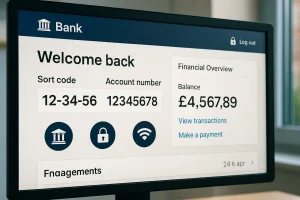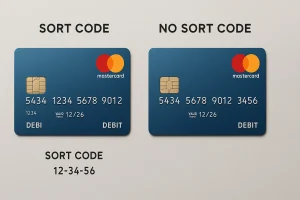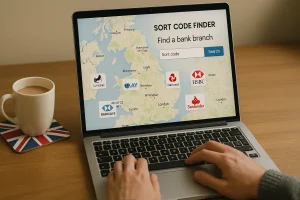
Where Is the Sort Code on a Debit Card and How to Find It Easily?
In the UK, banking details are crucial for managing finances, sending or receiving payments, and verifying identities.
Among these details, the sort code plays a significant role. While many assume it’s always visible on their debit cards, this isn’t always the case.
So, where is the sort code on a debit card and how do you find it easily if it’s not there?
This comprehensive guide explains where to look, how to understand what a sort code does, and what to do if it’s missing from your card.
What Is a Sort Code and Why Is It Important in UK Banking?

A sort code is a six-digit numerical code used within the UK banking system to identify both the bank and the specific branch of a customer’s bank account.
These codes play a crucial role in the routing of domestic payments. Every bank branch in the UK is assigned a unique sort code which ensures that transactions are directed to the right institution.
Typically written in the format of three pairs (e.g. 12-34-56), sort codes are a standard element of every UK bank account.
When paired with the account number, they allow seamless bank-to-bank transfers, direct debit arrangements, and standing orders.
Sort codes are vital for:
- Routing payments correctly within the UK
- Setting up employer salary deposits
- Authorising direct debits and standing orders
- Identifying the bank and branch linked to an account
Although not used internationally, sort codes remain fundamental to domestic financial transactions.
Where Can You Usually Find the Sort Code on a Debit Card?
In many UK-issued debit cards, the sort code is printed on the front side of the card. It is typically positioned near the account number or below the cardholder’s name.
However, exact placement may vary depending on the bank and the card’s design.
For example, in traditional Barclays cards, the sort code is often located directly beneath the 8-digit account number.
Some banks may present the sort code next to the account number or above the card’s expiry date.
Here’s how major UK banks typically display the sort code:
| Bank | Sort Code Location on Card | Notes |
| Barclays | Front of the card, below account no. | Usually visible on traditional cards |
| HSBC | Sometimes on the front | May not appear on newer card designs |
| NatWest | Front of the card | Clear format with account number |
| Lloyds Bank | Front, near bottom edge | Paired with account information |
| Monzo | Often not printed | Details accessed digitally via the mobile app |
If the card uses a vertical or minimal design, banks may exclude printed sort code details entirely.
Is the Sort Code Always Printed on Every UK Debit Card?

Although it is common for traditional debit cards to display the sort code, it is no longer uaranteed.
Some banks have removed these details from physical cards as a security measure or due to the move toward digital banking.
In these cases, customers may not find their sort code on their card but can still access it through:
- Online banking platforms
- Mobile banking applications
- Printed or electronic bank statements
- Direct communication with the bank
Digital banks and challenger banks like Starling or Monzo often omit all account identifiers from the physical card. Their focus on app-based banking encourages customers to retrieve such information securely within their mobile apps.
How Can You Find the Sort Code If It’s Not on Your Debit Card?
If your debit card doesn’t have the sort code printed, several alternatives exist for finding it. Most of these are secure and accessible 24/7.
1. Online Banking Platforms
Online banking portals display your sort code in the account overview section. After logging into your account, navigate to the specific account page where the sort code is listed next to or under your account number.
2. Mobile Banking Applications
Nearly every UK bank has a dedicated mobile banking app. The sort code is typically displayed on the main dashboard or account summary screen.
These apps are updated in real time, making them a reliable source for accurate banking details.
3. Bank Statements
Both paper and digital statements include the sort code, usually printed at the top or near your account number.
This method is especially useful for customers who prefer physical documents or are not comfortable with mobile apps.
4. Branch Visit or Customer Support
Visiting a local branch allows customers to retrieve their sort code in person. Most banks also offer helplines that can confirm your sort code after verifying your identity.
How Does the Sort Code Differ from an Account Number?
Understanding the difference between a sort code and an account number is essential for ensuring that financial transactions are completed correctly.
A sort code identifies where your account is held, while the account number identifies which account is yours within that bank branch.
Both are required when receiving payments or setting up recurring transactions.
Here is a detailed comparison:
| Feature | Sort Code | Account Number |
| Purpose | Identifies the bank and branch | Identifies individual account |
| Format | 6 digits (e.g. 12-34-56) | 8 digits (e.g. 12345678) |
| Printed on Debit Card? | Often, but not always | Typically printed |
| Used In | Domestic UK payments | Domestic and international use |
| Required For | Bank routing, direct debits | Receiving or sending funds |
Banks require both pieces of information to ensure accurate and secure money transfers.
Can You Use a Sort Code to Identify the Bank and Branch?

Yes, sort codes are specifically designed to represent both the bank and its branch.
The UK banking infrastructure assigns unique sort codes to each branch location, and by checking the code, one can identify the exact branch associated with a customer’s account.
There are online tools such as sort code checkers and branch identifiers where users can input a sort code and receive:
- Bank name
- Branch address
- Branch phone number
- Additional routing information
For example, if a sort code starts with “20”, it typically belongs to Barclays. Similarly, codes starting with “60” are often associated with NatWest.
Some banks may consolidate branch services, so a sort code may not always correspond to a physical location in current operations. However, it still retains routing functionality within the system.
Why Might Your Sort Code Be Important for Direct Debits and Transfers?
The sort code is one of the most important elements for processing everyday financial activities.
When setting up a direct debit or standing order, both your sort code and account number must be provided accurately.
These details ensure that funds are taken from or deposited into the correct account.
Key use cases for sort codes include:
- Employer payroll and salary deposits
- Utility and subscription bill payments via direct debit
- Standing orders for regular payments such as rent or savings
- Personal and business bank transfers within the UK
If a sort code is entered incorrectly, the funds may either be misrouted or rejected entirely. That’s why financial institutions double-check this information during setup processes.
How Secure Is Your Sort Code and Account Number Information?

Sort codes and account numbers are not classified as high-risk data when used on their own. However, they still deserve basic protection to prevent misuse.
On their own, they cannot be used to withdraw funds but can potentially be used to set up unauthorised direct debits or social engineering scams.
While it’s common to provide these details to employers, billing agencies, and government bodies, individuals should exercise caution and avoid sharing their sort code and account number in the following contexts:
- Public forums or social media
- With unknown online vendors
- Through unsecured websites or emails
If you suspect that your details have been compromised, immediately contact your bank for assistance. They can cancel transactions, freeze your account, or issue a new account number if necessary.
Additional Tips for Managing UK Banking Information
Managing banking details securely is part of responsible financial behaviour. Here are a few practical suggestions for handling sort code and account number information:
- Use password-protected apps to store banking information securely
- Keep physical statements in a locked drawer or cabinet
- Avoid sharing photos of debit cards online
- Periodically review your account for unauthorised transactions
- Verify bank details directly with organisations requesting them
Understanding where and how to find your sort code ensures that you remain in control of your finances, especially in an increasingly digital banking environment.
Conclusion
Finding the sort code on a debit card is usually simple it’s often printed on the front of the card, near the account number.
However, not all banks follow the same layout, and many are moving towards minimal or digital-only cards.
If your card doesn’t display your sort code, online and mobile banking apps, bank statements, and customer support remain reliable sources.
Understanding your sort code is essential for managing finances in the UK. Whether you’re receiving payments or setting up transfers, knowing where to find this six-digit number can save time and prevent errors.
Frequently Asked Questions
What does a UK sort code look like?
A UK sort code is a six-digit number formatted as three pairs (e.g. 12-34-56). It identifies the bank and branch handling your account.
Can you find the sort code in a banking app?
Yes, most UK banking apps show the sort code on the account overview screen, typically under the account holder’s name.
Is the sort code needed for setting up salary payments?
Yes, your employer will usually require both your sort code and account number to deposit your salary correctly.
Are sort codes the same for every customer of a bank?
No, sort codes differ by branch. Two people using the same bank may have different sort codes if their accounts are held at different branches.
Can I find my sort code using my IBAN number?
Yes, in many cases. Your IBAN includes your sort code and account number. You can extract it or use an IBAN-to-sort code converter tool.
Is it safe to give out your sort code and account number?
Generally, yes especially when giving it to employers or trusted organisations. However, avoid sharing it publicly or with unknown parties.
What should I do if I can’t find my sort code anywhere?
Contact your bank directly or check your online banking platform. Bank statements also reliably display your sort code.





